MATTERS OF THE ART
Cape Town’s Church Street: a powerful ‘contact zone’ where diverse arts and crafts connect

What makes Church Street such a fascinating location is not only the number of different art galleries all sharing one stretch of street in Cape Town’s CBD, but also the diverse nature of the identity of every gallery space.
As you stroll along the street, life is teeming from all corners. The centre is filled with vendors selling goods most likely directed towards the eyes of tourists that frequent the city centre. The street itself can be read as a “curatorial moment of geographical proportions”, as the well-known Swiss-born curator Hans Ulrich Obrist puts it. He defines curating as an operation of “connecting cultures, bringing their elements in proximity with each other — the task of curating is to make junctions, to allow different elements to touch.”
Visitors to Church Street are presented with a buffet of art on a cobblestone platter. From commercial galleries like Nel on Long, Eclectica Contemporary, WORLDART, 99 Loop Gallery, to AVA Gallery a non-profit art organisation which traces its origins to the oldest art body in South Africa, the South African Fine Arts Society. There is not only a diversity of art to engage with but also curatorial practices, and at times, curatorial absences, surrounding the art.
It is no coincidence that Church Street has become the First Thursdays hub in Cape Town. With all these galleries in such proximity to one another, it ensures an evening filled with art whilst still being able to end up on the intersecting Long Street with a buzzing energy to end off the night with friends. All three gallerists from Eclectica Contemporary, Nel on Long, and WORLDART expressed how invaluable it has been to be part of this art node and the immense foot traffic this has afforded them, especially on First Thursdays. With the knowledge that this does not hugely affect their sales, the significance of having programming such as First Thursdays is the mass engagement with the art.
The nucleus of the street that is integral to reading Church Street as a curatorial moment are the vendors that are situated between the two lines of galleries on either side. Farai Muzeza, an informal vendor who has been working from Church Street for 13 years, has appreciated the benefits that arise from the unique configuration of this locale.
“It’s been good because it is very busy and that means there is more of a chance to make a lot of money. But on First Thursdays, that is when we really make our money. We have a very good relationship with the galleries. Whenever they have openings, they will tell us so we can know if there is an opportunity to open till late,” says Muzeza.
He also touches on the variety that this contact zone affords visitors, explaining that, “it’s nice because they are selling fine art, and we can sell affordable ‘craft’ pieces. Many of us here also do fine art, so the proximity to these galleries is great as our work also becomes visible to them and the people coming to see the galleries.”

Luan Nel is an artist, turned art dealer, who established Nel on Church Street just before Covid-19. (Photo: Supplied)
Muzeza’s products range from intricate works of wire to detailed wood carvings of animals synonymous with Southern Africa. Craft doesn’t seem an apt definition for his wares when you consider Melissa Barker’s mud vessels at Eclectica Contemporary, or some of the sculptural works of Hayden Malan up the road at 99 Loop. This juxtaposition of art and craft on Church Street makes for a visible ‘contact zone’.
Curation
The function of curatorial practice is to act as a bridge — to close a gap in meaning, rendering the curator a mediator of the art, relaying it to us in a manner that inspires generative thinking. Curator Tshegofatso Mabaso puts it well when she writes: “The curatorial is understood as an extension beyond the organisational tasks encompassed in the setting up of exhibitions, involving a sensibility or methodology for making connections between works, contexts, places and publics.”
Luan Nel, the owner of Nel on Long exposes a different perspective to the curatorial cultures that exist on Church Street. He juggles an extensive 30-year career as an artist alongside that of a gallery director and this shows in the projects at the gallery. He admits that as an artist himself he feels as though a distinctive difference between him and possibly other gallerists is the empathy imbued in his dealings with artists. This translates into the collaborative manner in which Nel chooses to curate.
“I just wanted to curate, even if it was just a shop front window. We looked for a couple of years for a space, and then this amazing building came up. It’s much bigger than I ever intended,” recalls Nel. He has courageously shouldered the weight of curating a two-storey space with an expansive window front that has birthed exciting projects, one of which was a performance piece by Belinda Blignaut entitled Mud Rites.

Nel gallery caught the attention with a performance piece in the window by Belinda Blignaut. (Photo: Supplied)
Mediating the connection of the body to the earth, Blignaut camouflaged herself against fragments of clay and sculptured vessels. You could slowly begin to see her emerge — giving this sense of a ‘breathing’ earth. This performance behind the window display had an interesting effect on passers-by who may not have intended to even visit the gallery but now were content with engaging with art in this almost private/public space of a window front. This interventionist element of surprise and wonder to the unassuming eye is a curatorial element that invites wider engagement with the work and subject matters that may not have occurred in the controlled setting of a gallery floor within the private enclosure of four walls.
Brick and mortar
Covid 19 also posed new challenges in the way art is presented, consumed and acquired. In distilling the impact of the pandemic on the art industry, art journalist and researcher, Mary Corrigall, suggested it caused a “shift from moving artworks to people rather than people to artworks. Traditional models for viewing and/or acquiring art were upturned. As such instead of people visiting galleries, art fairs, museums, live auctions or festivals to see art, the art had to be ‘brought’ to them via digital tools.”
This shift is seen rather clearly in the art dealers on Church Street who had to contend with the reality of their physical foot traffic coming to a halt. Shamiela Tyer, director of Eclectica Contemporary was surprised how the art industry adapted, with studio visits to meetings with artists taking place on Zoom. Shamiela explained with a chuckle, “they would just move me around the studio via the phone to view the work!” In addition to this transformation to the digital, Charl Bezuidenhout, the director of WORLDART also admits that “only eight per cent of my sales are credited to ‘walk-ins’, most works are sold via long-standing relationships fostered with collectors that can easily occur through virtual communication.”
This begs the question: what is the use of the brick and mortar, particularly if you take into consideration the rental costs that have burdened most of these galleries, especially in Cape Town City Centre? When posing this question to the multiple gallerists, a shared sentiment that rang through all of their responses is the need for public engagement to strengthen and solidify the footprint of the galleries and in turn that of the artists they show. Although the power of the virtual is not lost upon them, there is still a palpable currency that exists within the physical and makes the curatorial all the more important.
A contact zone
In this sense, without perhaps even knowing it, the galleries do rely upon one another to generate foot traffic and interest in visiting this part of the city. Where deep curatorial discourse in the form of walkabouts, discussions and curatorial interventions do occur on one hand, you can also be comforted by the more identity-entrenched and niche markets of galleries like WORLDART which serve as a continuous platform for Urban contemporary street art, or Eclectica who have an extensive history with the showcasing of Black portraiture and Pan Africanist outlook. The passion that drives the gallerists is evident even when choosing to focus on a specific type of art.
“This isn’t a job to me. I work all the time, but for me, it doesn’t feel like work. I always represent artists and work I feel passionate about, and according to my instincts and knowledge,” says Bezuidenhout.
With varying budgets, streams of revenue, and infrastructure it may be delusional to expect individual galleries to satisfy a wide audience of art lovers. To deem a space or a place or a series of events as a ‘curatorial moment’, do they need to be driven by clear intentions beyond commercial concerns? With this in mind, Mabaso’s definition of the curatorial as a “methodology of making connections between…places and publics”, implies that an organic organisation of different elements that meet in a common place could have a similar impact.
This contact zone in the form of the Church Street art node allows for what Obrist refers to as different cultural elements touching, which in and of itself is an ecosystem that becomes self-sustaining. It leaves us as the audience of this wider gallery network on Church Street to make connections significant to us across different curatorial terrains. Perhaps a curatorial dream deferred would be to see how can Church Street possibly move from just a contact zone to an intermingling zone using wider intentional programming that creatively bridges the themes, subjects, and styles of the different galleries that line the street, finding connections, contrasts and conflicts that may generate a wider discussion that truly continues to exist beyond this public/private epicentre of art in the heart of the city. DM
The text was produced as part of an arts journalism development programme by African Arts Content that was focussed on the Church Street Art Node.




















 Become an Insider
Become an Insider
Comments - Please login in order to comment.